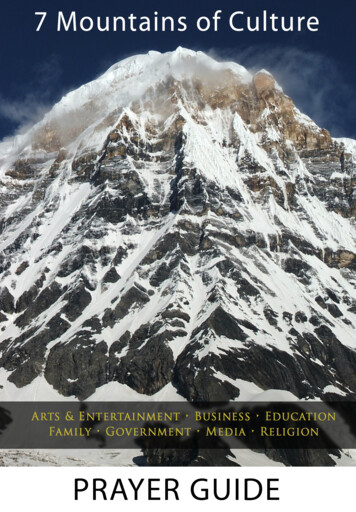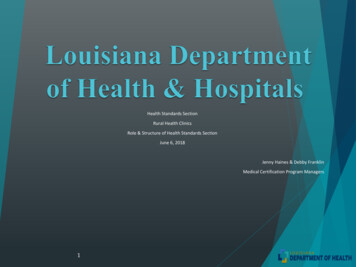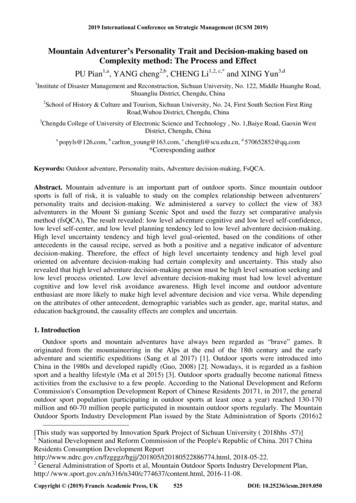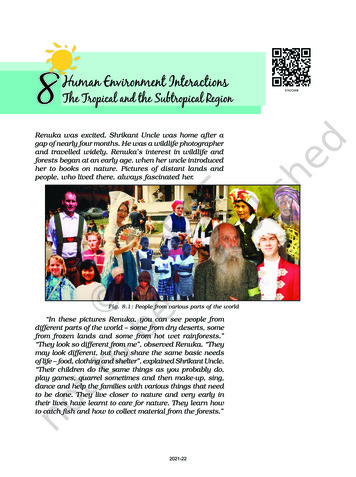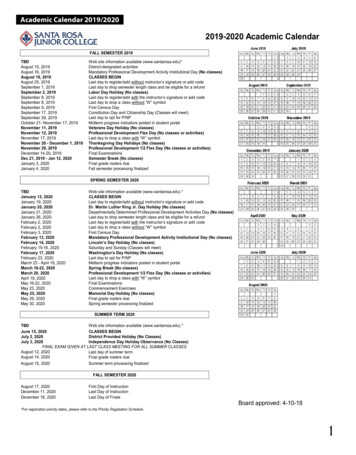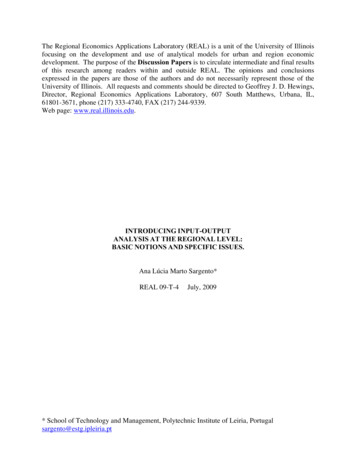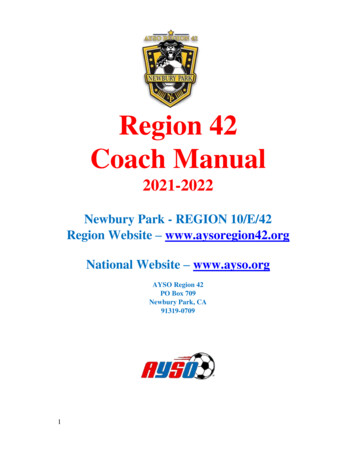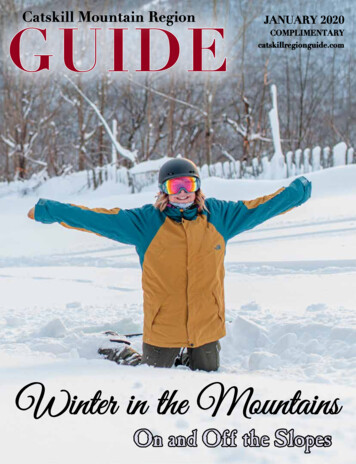
Transcription
Catskill Mountain RegionGUIDEJANUARY 2020COMPLIMENTARYcatskillregionguide.comWinter in the MountainsOn and Off the Slopes
www.catskillregionguide.comVOLUME 35, NUMBER 1 January 2020PUBLISHERSPeter Finn, Chairman, Catskill Mountain FoundationSarah Finn, President, Catskill Mountain FoundationEDITORIAL DIRECTOR,CATSKILL MOUNTAIN FOUNDATIONSarah TaftADVERTISING SALESBarbara CobbSteve FriedmanCONTRIBUTING WRITERSJoan Oldknow, Jeff Senterman, Sarah Taft& Margaret Donsbach TomlinsonADMINISTRATION & FINANCECandy McKeeIsabel Cunha, Justin McGowan & Emily MorsePRINTINGCatskill Mountain Printing ServicesDISTRIBUTIONCatskill Mountain FoundationIN THISISSUEOn the cover: Celebrate winter in the Catskill Mountains! See the section starting on page 8.Photo by Rob Sharpe, courtesy of Hunter Mountain2 BOOK REVIEW: Compassionate Cuisine, A Cookbook fromCatskill Animal Sanctuary Review by Sarah Taft3 LITERARY ARTS: Catskill Mountain Foundation’s JanuaryWriter-in-Residence: Sofi Thanhauser4 ZVI Dance: MAIM (“Water” in Hebrew) at the Orpheum inTannersville this January By Joan OldknowSPECIAL SECTION: WINTER IN THE MOUNTAINS8EDITORIAL DEADLINE FOR NEXT ISSUE: January 10The Catskill Mountain Region Guide is published 12 times a yearby the Catskill Mountain Foundation, Inc., Main Street, PO Box924, Hunter, NY 12442. If you have events or programs that youwould like to have covered, please send them by e-mail to tafts@catskillmtn.org. Please be sure to furnish a contact name and include your address, telephone, fax, and e-mail information on allcorrespondence. For editorial and photo submission guidelinessend a request via e-mail to tafts@catskillmtn.org.The liability of the publisher for any error for which it may beheld legally responsible will not exceed the cost of space orderedor occupied by the error. The publisher assumes no liability forerrors in key numbers. The publisher will not, in any event, beliable for loss of income or profits or any consequent damages.The Catskill Mountain Region Guide office is located inHunter Village Square in the Village of Hunter on Route 23A.The magazine can be found on-line at www.catskillmtn.orgby clicking on the “Guide Magazine” button, or by going directlyto www.catskillregionguide.com7,000 copies of the Catskill Mountain Region Guide aredistributed each month. It is distributed free of charge at thePlattekill, Sloatsburg and New Baltimore rest stops on theNew York State Thruway, and at the tourist information offices,restaurants, lodgings, retailers and other businesses throughoutGreene, Delaware and Ulster counties.Home delivery of the Guide magazine is available, at anadditional fee, to annual members of the Catskill MountainFoundation at the 100 membership level or higher. 2000 Catskill Mountain Foundation, Inc.All rights reserved. Reproduction in whole or part withoutwritten permission is prohibited. The Catskill Mountain RegionGuide is not responsible for unsolicited manuscripts. All photographic rights reside with the photographer.THE CATSKILL MOUNTAIN FOUNDATION7971 MAIN STREET, P.O. BOX 924HUNTER, NY 12442PHONE: 518 263 2000 FAX: 518 263 2025WWW.CATSKILLMTN.ORG10SKI NY: Updates for the 2019-2020 Seasoninclude Discounts, Special Events & A New WebsiteWELCOME TO MINNEWASKA STATE PARK PRESERVE1217BELLEAYRE MOUNTAIN20242842PLATTEKILL MOUNTAINHUNTER MOUNTAINWINDHAM MOUNTAINOFF THE SLOPESEAT DRINK 28: A Food & Wine Lover’s DreamLocated in the Heart of the Catskills43 THE U.S. CHEFS SKI CLUB/CHEFS OF ALL NATIONS47 A GREENE COUNTY GARDEN IN JANUARYBy Margaret Donsbach Tomlinson48 THE GREAT OUTDOORS IN THE CATSKILLS By Jeff Senterman51 CATSKILL MOUNTAIN REGION GUIDE PHOTOGRAPHYPORTFOLIO: Ski & Ride the Catskills59 JANUARY AT THE CATSKILL MOUNTAIN FOUNDATIONJanuary 2020 GUIDE 1
BOOK REVIEWCompassionate Cuisine:125 Plant-Based Recipesfrom Our Vegan KitchenBy Linda Soper-Kolton and Sara BoanStories by Kathy StevensReview by Sarah TaftAs an avid home cook, a longtime vegetarian and a most-of-thetime vegan, I’m constantly on the search for plant-based recipesand cookbooks that are easy, tasty, satisfying, and good for you.Compassionate Cuisine, recently published by the good folks at theCatskill Animal Sanctuary, has rapidly become one of my favoritesources for great recipes, and has made it into heavy rotationin my household. Every recipe is absolutely delicious, from theChipotle Sweet Potato Lentil Stew and the Skillet Shepherd’s Pie,both perfect for warming you up after a cold winter’s day; to theStovetop Macaroni and Cheese, when you need a little ooey-gooey comfort; to the Chocolate-Coconut Oatmeal Cookies (I’m alittle embarrassed—but only a little—to say that the entire batchwas gone in two days, and there are only two of us in the house).In fact, I was so confident in Compassionate Cuisine thatmy Thanksgiving meal was made entirely using recipes from thebook, starting with the Southern-Style Cheese Ball (because youalways have to serve a cheese ball at Thanksgiving, right?), tothe Butternut Harvest Roll with Golden Gravy, to the BlisteredGreen Beans with Leeks and Shiitake Crisps, to the Sweet PotatoCranberry Crisp with Coconut Whipped Cream. We were hopingfor leftovers, but we went to bed that night with full bellies, warmhearts, and a pretty empty refrigerator.This is one of the most accessible vegan cookbooks I’veread—and I’ve read a lot. The recipes don’t use anything fancy,and most include items that are probably already in your pantry. No special equipment is required (although a high-poweredblender and a food processor do help), and you don’t need adegree from the Culinary Institute of America to understand thedirections. Chapter 1: “Getting Started” provides really helpfulinformation for both the long-time vegan and the new vegan2 www.catskillregionguide.comon ingredients, tools, and techniques in vegan cooking. The eggsubstitution chart is the easiest one I have come across yet, showing you exactly what to use for eggs in any recipe, along withadjustments that need to be made when using those substitutions.There’s also a helpful section on how to make small changes inyour diet if you haven’t yet made the transition to a plant-basedlifestyle.The recipes are interspersed with really wonderful, sometimesfunny, sometimes moving stories from the Sanctuary. You’ll meetnew friends, human and non-human alike, and learn that we’reall pretty much the same we all have distinct personalities thatshine through when we feel safe and loved.Very few of us grew up as vegans, only coming into it laterin life. Our reasons for becoming vegan are as varied as there aretypes of people in the world, but one thing is universal: we lovefood. We love cooking it, eating it, and thinking about it. One ofthe wonderful things about Compassionate Cuisine is that it doesnot shame or judge you into becoming vegan—it simply providesyou with the tools to make some really good food, to show youthat even small changes can make a difference, and that beingvegan doesn’t mean a life of just boiled squash, steamed veggies,and tofu.And lest the idea of a vegan cookbook scare you, let me assure you: these recipes are good. Really, really good. They’ll satisfyvegans and non-vegans alike, and you may learn a little somethingin between delicious bites.To order your copy of Compassionate Cuisine: 125 Plant-BasedRecipes From Our Vegan Kitchen, go to casanctuary.org/cookbook.
LITERARY ARTSCatskill Mountain Foundation’sJanuary Writer-in-Residence: Sofi ThanhauserThe Catskill Mountain Foundation’s new Writers-In-Residence program ispleased to welcome January’s writer in residence, Sofi Thanhauser.Sofi was born in Dartmouth, NH and currently lives in Brooklyn.She works with text, drawings, books, found objects, video and otherthree-dimensional materials, often collaborating with other visual artistsor writers. In addition to her own original content she will borrow, cite, orexpand on other philosophical or artistic works, integrating them into anew context. She has been an artist-in residence at Jentel, Ucross and BushCreek in Wyoming, the Millay Colony in NY, and the VCCA in Virginia.During her stay with us in Tannersville, she plans on working on afinal edit of a new book, Worn, which is about clothing and deals withimperial, women’s labor and environmental histories.The Catskill Mountain Foundation’s Writers-In-Residence programinvites a writer to come and live and work on Main Street in Tannersville.A residency can provide a rare and welcomed chance to leave behind all ofone’s responsibilities in order to focus on one’s work for a specific (usuallya month) period of time. The program is run by CMF Gallery Director,Robert Tomlinson, and will be, for the first 6 months, by invitation only.For more information about the residency, please contact Robert attomlinsonr@catskillmtn.org.January 2020 GUIDE 3
All photos by Heidi GutmanMAIM (“Water” in Hebrew) at theOrpheum in Tannersville this JanuaryWBy Joan Oldknowater, considered in Western Culture to be one of the fourmain elements essential to life, is diminishing in quantityand quality due to the effects of global climate change. Like earth,air, and fire, water is a complex system of life-threatening and lifesustaining classical elements of nature. If the earth is 2/3 water,and the human body is 70% water, then no life can be sustainedwithout water. We know that the water cycle sustains life, but westill continue to take it for granted.line surrounded by armed guards to collect drinking water. Andin Mexico City, many of the 21 million residents will only haverunning water part of the day and these are only two examplesfor a growing global trend of water shortage. To bring awarenessto such man-made devastation, Gotheiner will anchor his artisticinvestigation to his personal experience.MAIM (“Water” in Hebrew)While still living in the kibbutz, Zvi Gotheiner enjoyed folkdancing on Friday nights. This was a popular recreational activity,a mish-mosh of folk dance from the collective of the Jewish Diaspora, including Arabic dancing borrowed by Israelis. Folk dancingis still a vibrant form that is being changed and re-choreographedto new popular music. It is dynamic and fun.At the age of 17, Zvi had the opportunity to see a performance by Batsheva Dance Company, and he was smitten. Zvi’sfirst attempt at choreography came before becoming a dancer.While growing up in the kibbutz, Zvi forced himself to join agroup that put together shows for the girls. The director of thegroup became pregnant, so Zvi choreographed a dance for tenA new work by ZviDance, MAIM (“Water” in Hebrew), seeks toraise awareness of the world’s diminishing water resources due toglobal warming. Israeli Zvi Gotheiner grew up in Kibbutz Messilot on the slopes of Mount Gilboa, where King David cursedthe land with no rain or dew in his biblical mourning elegy to hisbeloved Jonathan. Droughts, water shortage and the need for water conservation were powerful tensions in Gotheiner’s early years,epitomized by the government’s slogan “Every Drop Counts.”Later, Gotheiner would learn the significant role water, or thelack thereof, played into the war politics of the region. This year,four million people in Cape Town, South Africa, will stand in4 www.catskillregionguide.comAbout Zvi:His Career in Dance & Choreography
children. Having trained as a violinist, he understood the musicalpositions.While stationed in Tel Aviv for his Israeli Army service, Zviwas able to pursue dance training in the evenings, studying underthe famous choreographer Gertrud Kraus. Years later in NewYork, Zvi was injured while performing with the Feld Ballet,which brought him back to choreography. At first choreographingworks for just a few friends, it took about ten years for Zvi to feelthat his work was not just exercises anymore.The Dancers andthe Collaborative ProcessThe dancers who are part of ZviDance come from all differentbackgrounds, and are instrumental in the creation of a new work.There is no hierarchy within the company, similar to Zvi’s experience within the kibbutz. The collective process is not always inagreement. When someone is less secure, they must rely on onlywhat they know. The creative moment comes from new ideas andperspectives. Zvi believes that the craft of dance requires gainingknowledge. When the company initiates a new work, they beginin the dark, with a blank slate. Working together with their collaborative artists and dancers, they move forward, and the dancemiraculously appears. “With all of those voices, somehow I’m ableto navigate through it,” said Zvi.With so many opinions, it may come as no surprise that inthe choreographic process the company has what Zvi refers to as“delicious misunderstandings.” A work usually begins in January, takes ten months to initiate and develop, and then falls intoplace in the fall. Company dancers may work elsewhere, eitheras a dancer or in some other type of work, but they want to be atrehearsal.To finish the choreography, the dancers must come togetherand rehearse in a residency, where they can focus on the workfor an extended period of time. Thanks to a grant from the NewYork State Council on the Arts, ZviDance will be in residence atthe Catskill Mountain Foundation for three weeks in January of2020 honing MAIM, as well as other works. This residency willculminate in a performance of MAIM at the Orpheum Film &Performing Arts Center in Tannersville on January 18.About MAIM (“Water” in Hebrew)When developing new works, Zvi communicates who we are asa society, and chooses themes that reflect something about ourtime. In MAIM (“Water” in Hebrew), there is a sense of a lostwar. ZviDance tries to say that many of us consume nature, butalso give back to it. There are few works dealing with this topic.Zvi is aware that MAIM, which is pronounced “MY-EEM”and alludes to the discovery of water in the desert, can be polarized politically. In the choreography, all of the dancers participateand there is a heartfelt understanding of the potential of the work,the difference between enlightenment and ignorance. Zvi is awareof the power to shape perceptions, both as an individual artist andas one of the artists. The effect of the work on the audience canbe either life-changing or one of appreciation. There may also beother layers that the audience might draw out of the work basedupon their own insights.Not functioning in a particular recognizable style, the workhas its own style. It is a collaborative effort; not just steps, but alsothe texture. It is dynamic, moving with style, blending with othersensibilities and subtleties. The movement vocabulary is surprising, referring to other styles of dance, including folk dancing.ZviDance initiated MAIM’s creative process during a threeweek residency, supported by NYSCA’s Long-Term ResidencyGrant, in Catskill, NY, hosted and commissioned by Lumberyardin January of 2019. More than half of the ZviDance cast is new,so they bring new things into the mix. They anchored the beginning of the work in the kibbutz, going deeper into the water issuein Israel, which was manifested in the politics of the Palestinianconflict. As it developed, it became more specific and the movements evolved.ZviDance’s renowned creative team includes composers ScottKillian, media designer Joshua Higgason, lighting designer MarkLondon and ZviDance’s athletic and expressive dancers: AlisonClancy, Doron Perk, Eila Valls, Jessica Smith, Michael Wang,Nathaniel Hunt, Zachary Gonder.January 2020 GUIDE 5
IMAGES OF THENORTHERNCATSKILLSBy Francis X. DriscollFor more information visitwww.francisxdriscoll.comAbout ZviDanceZviDance brings its audiences a passionate vision of community in a modernage. A collaborative alliance amongartists, the company’s stirring work celebrates diversity by melding movementgenres into the distinct dance vocabulary constantly evolving and refusing tosuccumb to dialectics of the medium.The company is shaped by a collaborative model of creation, involving theensemble and designers from the initialresearch phase, so as to constantly pushthe methodology and ethics of a creationprocess within an inter-disciplinaryformat. Each piece defines a unique setof relationships and experiences, boldlyaddressing the depths of the human experience. ZviDance also exists to engagestudents in enriching their appreciationof the art form.In the last 30 years of existence,ZviDance has received critical praise andstable funding for its artistic projects,a work that fearlessly refuses to bebounded to specific thematic or aestheticdogma. The company performs frequently at home in such New York venues asthe Brooklyn Academy of Music (BAM),Joyce Theater, New York Live Arts andLincoln Center Out-of-Doors. ZviDancehas toured across North America to festivals such as Jacob’s Pillow Dance Festivaland The American Dance Festival, andabroad to Germany, Poland, Russia,Israel, Colombia, Brazil, Ecuador andJapan.ZviDance at theOrpheum inTannersvilleCatskill Mountain Foundation presentsZviDance in a performance of MAIM(“Water” in Hebrew) on January 18,2020 at 8:00 pm at the Orpheum Film& Performing Arts Center, 6050 MainStreet, Tannersville, NY 12485. Generaladmission tickets are 25, 20 for seniorsand 7 for students. Prices are higher atthe door. Tickets can be purchased onlineat www.catskillmtn.org or by calling theticket reservation line at 518 263 2063.6 www.catskillregionguide.com
Catskill Mountain Foundation presentsMAIM“One does not just watch a dance byZvi Gotheiner. One enters a world withits own internal logic, a sensual,organic world of movement, language,and images where one is pulled alongby currents unseen and inevitable.”—Dance Magazine(“Water” in Hebrew)A new work by Zvi Gotheiner that seeks to raise awareness of the world’sdiminishing water resources due to global warming.SATURDAY, JANUARY 18, 2020 @ 8:00 PMORPHEUM FILM & PERFORMING ARTS CENTER6050 Main Street, Tannersville, NY 12485Tickets Purchased Ahead: 25; 20 seniors; 7 studentsAt the Door: 30; 25 seniors; 7 studentsTickets available at catskillmtn.org or 518 263 2063Catskill Mountain Foundation is supported in part by New York State Council on the Arts, The Greene County Legislaturethrough the Cultural Fund administered by CREATE Council for Resources to Enrich the Arts, Technology & Education(formerly The Greene County Council on the Arts), The Jarvis and Constance Doctorow Family Foundation,The Royce Family Foundation, The Samuel and Esther Doctorow Fund, The Orville and Ethel Slutzky Family Foundation,Platte Clove Bruderhof Community, Bank of Greene County Charitable Foundation, The Greene County Youth Bureau,January2020 GUIDE 7Marshall & Sterling Insurance, All Souls’ Church, Stewarts Shops, Windham Foundation, and by privatedonations.
Photo courtesy of iskiny.comSKI/NYSUpdates for the 2019-2020 Season includeDiscounts, Special Events & a New Websiteki Areas of New York, Inc. (SKI/NY) is dedicated to thecontinued growth of the New York snow sports industry byworking on behalf of its membership to promote fair legislation,develop marketing programs, create educational opportunitiesand enhance the public awareness of snow sports throughoutthe State and region. At SKI/NY there are a number of excitingupdates for this season.passports will be mailed as soon as applications are processed viae-mail.SKI/NY Ski & Ride Passport ProgramDiscover NY Ski DaySKI/NY aims to introduce more kids to skiing and snowboardingwith its Ski & Ride Passport Program, which offers free lift tickets, discount lessons, and more. The Ski & Ride Passport Programaims to grow the sport of skiing for future alpine skiers and riders.This year marks the program’s 20th season. Since that firstseason, the Passport Program has introduced thousands of kids toalpine winter sports. This year, there will be no blackout dates forthe free lift ticket program, but blackout dates will apply to theLearn to Ski & Ride part of the program, but only at a handful ofski areas.“This program is key to the future of the sport of skiing andoffers a great way to start,” said Scott Brandi, President of SKI/NY. “With the decision of the SKI/NY Board of Directors toeliminate blackout dates on part of the program, we are encouraging kids and families to ski together even more this winter!”The Ski & Ride Passport Program is available all season longwith a processing fee of 31 per Passport, per child. Parents mustapply online at iskiny.com and can ski the next day as temporary8 www.catskillregionguide.comDiscount Tickets and PackagesSKI/NY will offer discounted tickets this season, as well as learnto ski and snowboard packages and Ski & Stay info too. Look fordiscounts and packages at at iskiny.com.SKI/NY is once again hosting the annual Discover NY Ski Dayon January 16, 2020. This program offers discounted ticketsstarting at 12 and learn-to-ski or snowboard packages starting at 25. Ticket sales are available at at iskiny.com.NYC Parks WinterSKI/NY returns as headline sponsor at the NYC Parks Winter onFebruary 1, 2020 in Central Park. This event introduces alpinesports to tens of thousands of people in the NYC area. Find outmore at iskiny.com or nycgovparks.org.New WebsiteFinally, SKI/NY has new look and a new website debuting forthe 2019-20 season. Featuring the latest in design and ease ofuse, the site features video, mountain information, webcam links,ski reports, ticket sales and more. Find the new website at iskiny.com, and connect with SKI/NY at facebook.com/ISKINY, andinstagram.com/i ski ny/.
January 2020 GUIDE 9
Welcometo MinnewaskaState Park PreserveThe Park Preserve is located on the dramatic ShawangunkRidge in Ulster County, New York. The Ridge, whichrises more than 2,000 feet above sea level, dominates the ParkPreserve and the pastoral valleys below it. Characterized byunique and sensitive environments, the Park Preserve is valuablefor its many rare geological and ecological features. The terrainis rugged and rocky, blanketed by dense forests encircling foursky lakes. Clear streams cut into valleys, pour over sheer cliffsand ledges and emerge as waterfalls. The Park Preserve has anextensive trail network that traverses the landscape. This networkincludes 35 miles of carriage roads and 50 miles of footpaths thatprovide access to countless natural attractions. Minnewaska offers numerous recreational activities such as hiking, biking, crosscountry skiing and snowshoeing.History of MinnewaskaThe property comprising the Park Preserve has evolved from aprivate summer resort to its use today as a State Park Preserve.In 1869, Albert and Alfred Smiley, twin brothers from Providence, Rhode Island, purchased property that included Mohonk10 www.catskillregionguide.comLake from John F. Stokes and developed the Mohonk MountainHouse. In 1876, after discovering nearby Coxing Pond on a family picnic, Alfred Smiley purchased the surrounding 2,500 acresand renamed it Lake Minnewaska. Cliff House, the first Minnewaska Mountain House, opened in 1879 and was located onthe east side of the Lake. Its immediate popularity prompted Alfred to build a second resort in 1887, the Wildmere, which waslocated on the north end of the Lake, where the main parkingarea is currently found. In 1955, the Smiley family sold the Minnewaska Mountain Houses and surrounding estate to KennethPhillips, who had served as the general manager of the property.Ultimately, both Minnewaska Mountain Houses burned down;Cliff House in 1978, followed by the Wildmere in 1986. From1971 to 1987, the New York State Office of Parks, Recreation,and Historic Preservation gradually acquired parcels of the landfrom the Phillips family, turning it into a state park. In 1993,Minnewaska was granted its Park Preserve status. Today, Minnewaska consists of over 23,000 acres of protected land, whichincludes four sky lakes, seven waterfalls, and numerous scenicvistas. Minnewaska’s historic carriage roads, which were original-
ly built over a hundred years ago by the Smiley family, serve as aframework for access and use throughout the Park Preserve. Theintention of the carriage roads was and still is to be both aesthetically pleasing and functional, while providing a safe and comfortable journey to previously inaccessible and rugged terrain.These carriage roads offer a multitude of recreational opportunities and are utilized as the groomed ski trails in the winter.Life at MinnewaskaThe forests of Minnewaska serve as habitat for various animals, including but not limited to black bears, coyotes, fox,white-tailed deer, porcupines, and the state-threatened easterntimber rattle snake. The pitch pine forests, located on higherelevation cliff areas, are a common feeding ground for raptors.An important part of this ecosystem, the pitch pine forests areuniquely adapted to survive on dry, exposed sites that are proneto fire. The Park Preserve provides outstanding bird habitat. Thelarge, intact forest landscape along the Shawangunk Ridge is asignificant resting point for migratory birds. Many of the birdspecies supported by the forests of Minnewaska have been listedas Species of Greatest Conservation Need, including the RedShouldered Hawk, Whip-poor-will, Wood Thrush, and CanadaWarbler. This unique bird community has been recognizedthrough designation as a Bird Conservation Area by OPRHP/PIPC.Winter at MinnewaskaWinter is an excellent time to explore the Park Preserve, asthe landscape changes and cross-country skiing opportunitiesare plentiful. The cross-country skiing opportunities at Minnewaska are outstanding. Minnewaska offers over 26 kilometersof machine-groomed trails for all ability levels, providing bothclassic and skate skiing opportunities. The breathtaking vistasthroughout the groomed trail network are amazing. Be sure tobring your camera to capture some of the unique winter landscapes, ice formations and animal tracks. Park Educators offerregularly scheduled winter ecology and recreational snowshoeoutings throughout the winter, as conditions warrant. Numerous snowshoeing opportunities are available on footpaths andungroomed carriage roads, but snowshoeing is not permitted onthe groomed cross-country ski trails. Hiking, walking, dogs andfat tire biking are not allowed on Minnewaska’s groomed crosscountry ski trails.A Visitor Center, which is currently under design, willprovide a central area for visitors to gather and embark on theirMinnewaska adventures. The Visitor Center will feature afireplace for winter warming, dramatically improving our visitorexperience. The Open Space Institute is raising private funds forour new Minnewaska Visitor Center. Please open the followinglink to donate or learn more: ka-visitor-center-campaignPark staff works closely with the local not for profit organization the Shawangunk Nordic Ski Association, which is a goodresource to obtain current conditions from skiers’ perspectives.The Park Preserve has hosted public ski races and clinics with theexpertise of the Shawangunk Nordic Ski Association membersproviding lessons and race administration. http://www.skithegunks.com/Minnewaska State Park Preserve also hosts Section 9high school ski races in the Winter.Please be prepared for your outing, always be in tune withthe weather forecast, and bring enough food and water. Bringyour cell phone and make sure it is charged. Carry a map andlet someone know where you are heading, especially if you arealone on your outing. Minnewaska’s webpage provides updatedski conditions visit https://parks.ny.gov/ or call the Park Preserveoffice at 845 255 0752.January 2020 GUIDE 11
BELLEAYRE MOUNTAINMOUNTAIN STATS:Longest Run: 12,024’Vertical Drop: 1,404’Total Skiable Acres: 175Snowmaking: 96%Uphill Lift Capacity: 12,980 people/hourELEVATIONS:Belleayre Summit: 3,429’Sunset Lodge (summit lodge): 3,325’Overlook Lodge (mid mtn. lodge): 2,542’Discovery Lodge (lower mtn. lodge): 2,025’TRAILS, PARKS & GLADES:50 Trails, 5 Glades, 1 Terrain Park,1 Progression Park & 1 X-Course22% Easiest Trails58% More Difficult Trails20% Most Difficult TrailsCROSS COUNTRY TRAILS:9.2 km of trails. The cross country trails are freeto use and are only open with natural snow.They are not patrolled or groomed.EIGHT LIFTS:1 Gondola: “Catskill Thunder” located next tothe Discovery Lodge. Services intermediate &expert terrain1 Detachable High Speed Quad: “Super Chief”located in the Intermediate/Expert Area1 Fixed Grip Quad: “Tomahawk” located in theIntermediate/Expert Area1 Fixed Grip Quad: “Lightning” located in theNovice/Beginner Area1 Triple Chair: “Lift #7” located in the Intermediate/Expert Area1 Magic Carpet: “Running Bear” Located in theNovice/Beginner Area /Tee Pee Flats1 Magic Carpet: ”Little Creek” Located in theNovice/Beginner Area/ Tee Pee Flats1 Magic Carpet: “Kaatskill Katerpillar” Locatedin the KidsCamp Area. For children enrolled inKidsCamp Program onlyWINTERHOURS OF OPERATION:Lodges: 8:00am - 5:00pmLifts: 9:00am - 4:00pm181 Galli Curci Rd Highmount, NY 12441800-942-6904 845-254-5600 belleayre.com
WHAT’S NEW ATBELLEAYRE?Photo courtesy ofBelleayre MountainModernization and Renovations to the Discovery Lodge,One New Lift and a New Beginner Teaching Area!DISCOVERY LODGEThe Discovery Lodge expansion and modernization project atBelleayre Mountain Ski Resort has continued New York’s investment in the Highmount ski area, designed to increase year-roundvisitation, enhance customer experience and be a catalyst for thetourism industry in the Catskill Region.The architectural style of the new lodge is that of a Scandinavian great-camp, featuring long sloping roof lines, horizontalsiding and accented with stone elements throughout. The expansion ensures a greater resort experience, able to accommodate theincrease of visitor attendance by delivering more amenities andbroader services.Alleviating long lines and overcrowded spaces, the impro
not shame or judge you into becoming vegan—it simply provides you with the tools to make some really good food, to show you that even small changes can make a difference, and that being vegan doesn’t mean a life of just boiled squash, steamed veggies, and tofu. And lest the idea o
